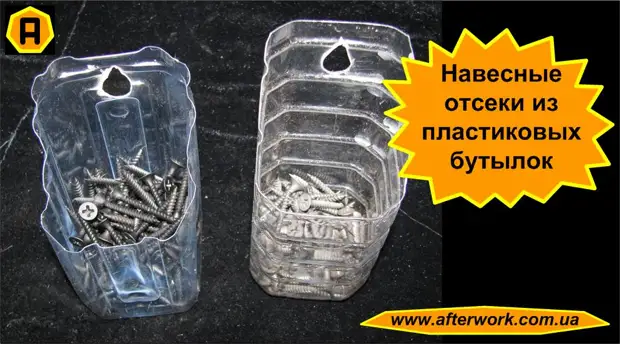
Plastic bottle - first of all, compartment or container for storing liquids. It is easy to convert a variety of non-liquid items. Due to the variety of volumes and shape of the bottles, you can choose a bottle for various storage items. When plastic bottles were just-only included in our convenience, I immediately involved them for storing small scattering details. Especially convenient is the fact that in the pile of small items located in a plastic storage bottle, it is easy to find the desired part, even if it is at the bottom itself. It is clear that the plastic bottle should be transparent and, desirable, colorless plastic.
Idea and solution
For convenience, compartments or glasses of plastic bottles of different sizes can be connected to blocks. How much I made these containers and blocks, it is difficult to count hard. In my arsenal there are linear, two-dimensional and even bulk blocks of containers from plastic bottles, but they were all not fixed, just stood on the shelf, in a box or table. Recently, we often fasten them on vertical surfaces, as everyone else is already occupied ...
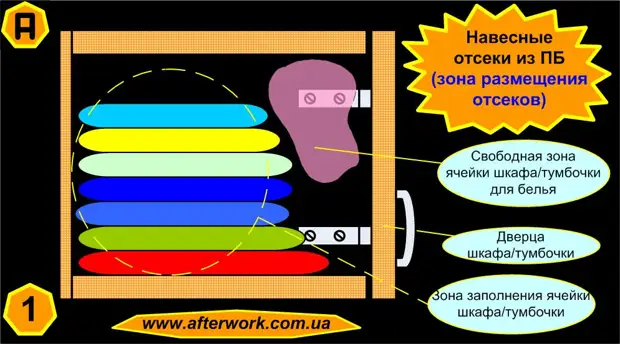
And where to take a place on these most vertical surfaces to install the blocks of containers from plastic bottles? From the experience of using the cabinet cells, it notifies that the inner zone of the cabinet is not completely used, the upper part of the cell adjacent to the cabinet door remains free. This is such a free zone is just available to accommodate hanging containers from plastic bottles, if a block or a separate container is fixed in the top of the door (Fig. 1). After closing the door of the cabinet, hanging compartments from plastic bottles are in the free zone. Ultimately, the coefficient of use of the closet cell volume is increasing, i.e. The wardrobe accommodates more, and this is very nice.
The first free zone was painted on the kitchen bed door (Fig. 2) with washing for dishes. Sometimes, in the lower part of a similar door, a garbage bin is fixed, but I regretted the door loop and the garbage bucket did not place there, but placed a block of containers from plastic bottles from lactic kefir (heh, whatever they merged with a white internal coating of the door ).

Such a hanging compartment of four containers is assembled on a plastic tape from a transparent plastic bottle (Fig. 2). To collect a container, you need to install 14 plastic rivets. The entire container is fixed on the door with 2 small screws. In principle, plastic tape - the jumper can not be used, then the unit will be somewhat less hard.
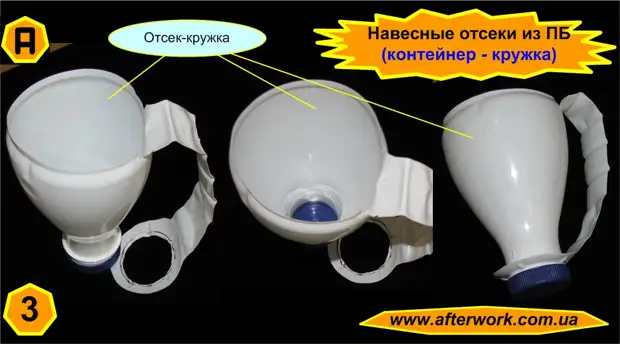
For the manufacture of hanging containers, not only the lower part of the plastic bottle can be used, but also the upper, adjacent to the neck. When the lower parts of the bottles were already involved, the mountain of the upper parts remained, which also "asked" to become containers. They are manufactured on the principle of manufacture of a plastic bottle of mugs with a handle (how to do, probably everyone knows, even children). Circle containers were conceived (Fig. 3) for use in trade places and placed on a horizontal rod, welded directly to the iron vertical wall of the trading place.
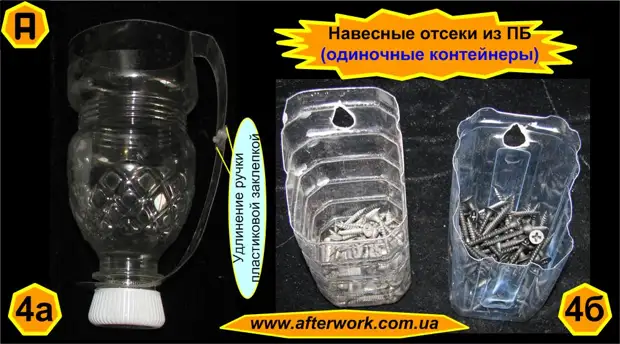
If necessary, such a container with a handle can be used as a mug for beverages. There you can also temporarily put a cup with coffee or place ballpoint handles, minor money, etc. The handle of the hanging "shopping" container can be made of the same bottle as the container itself, or is made of part of another plastic bottle (Fig.4A). Create a handle on the container itself or it is possible to lengthen it with the help of the technology of plastic rivets (which I am so you already need and not needed). Recently, it seemed convenient to store small items in autonomous mounted plastic containers made of plastic bottles of square shape (Fig. 4b).
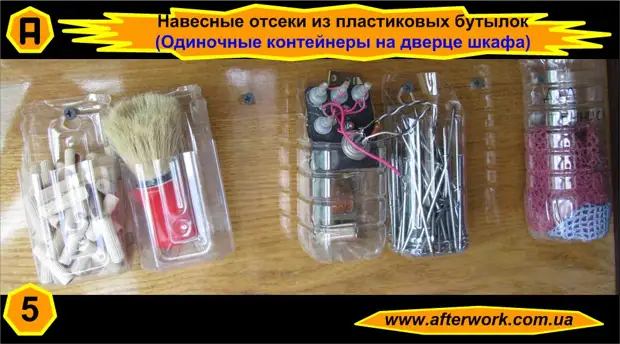
Such autonomous containers are placed in a row on the inner surface of the door of the working cabinet (bedside tables, antlesol, etc.). If necessary, it is easy to remove a separate container, digging into it and hang to the previous place (Fig. 5). If the size of the containers and the attachment points are unified, then after use or inspection of the internals, the container is installed on any free space. Such an approach was extremely convenient for my all increasing arsenal of the hlama.
Hanging containers will find their use not only for economic trifles. If you place them in a lounge closet, then you can store fine clothes or various rims to clothing (for example, belt, ties, panties, socks), packed so that they fit into the volume of the container (Fig. 6). Moreover, homogeneous items will be located in one row, and if there is no object, it is easy to see its absence over an empty container.

If many containers and blocks are required, for example, when the items of a separate family member are needed in each block "live", and there are many people using a wardrobe, then a pretty number of bottoms from plastic bottles are needed, and the upper part remains unsuitable. We use the use of the keeper container and unused part in the same role. You can do it, as shown in Fig.3. However, such containers in blocks are inconvenient, and the conical form by volume is less.
You can get a cylindrical container or a glass (truth, a leakage of a plastic bottle from a plastic bottle using a step of 1-2 cm to a depth of approximately 1 cm more than 1 cm and bending the resulting petals inside. In the heart of the petal, just one plastic rivet is connected (Fig. 6, right). The resulting glasses, of course, the water and sand will be skidding, but they are not found in the lounge closet.
If you do not know where you have, consider, you don't have it!
A source
